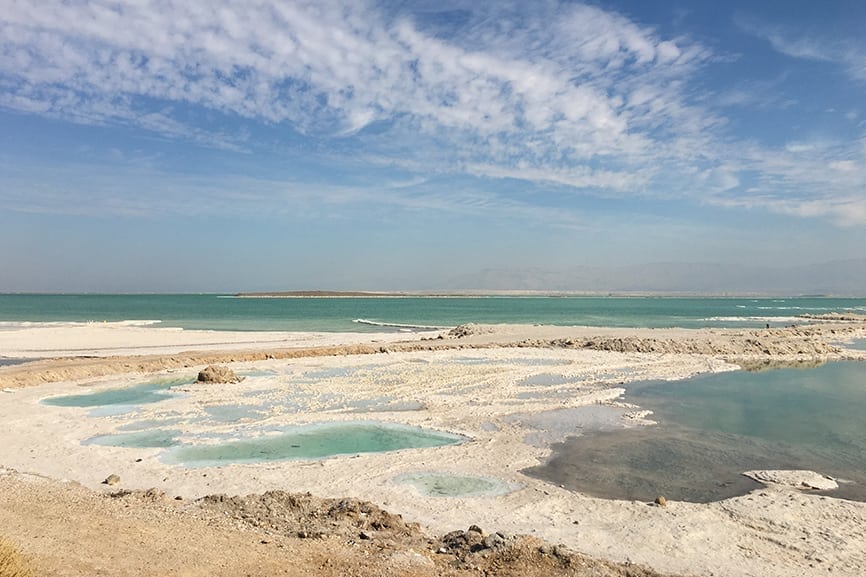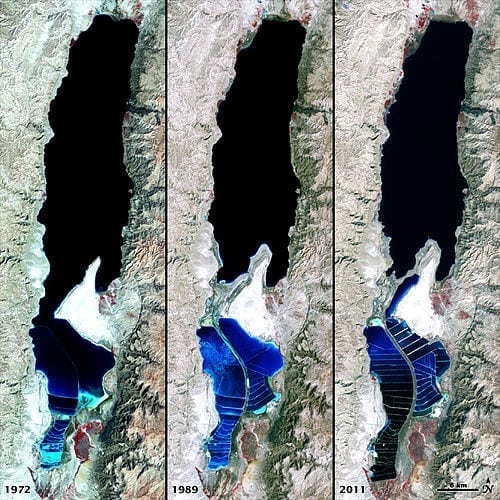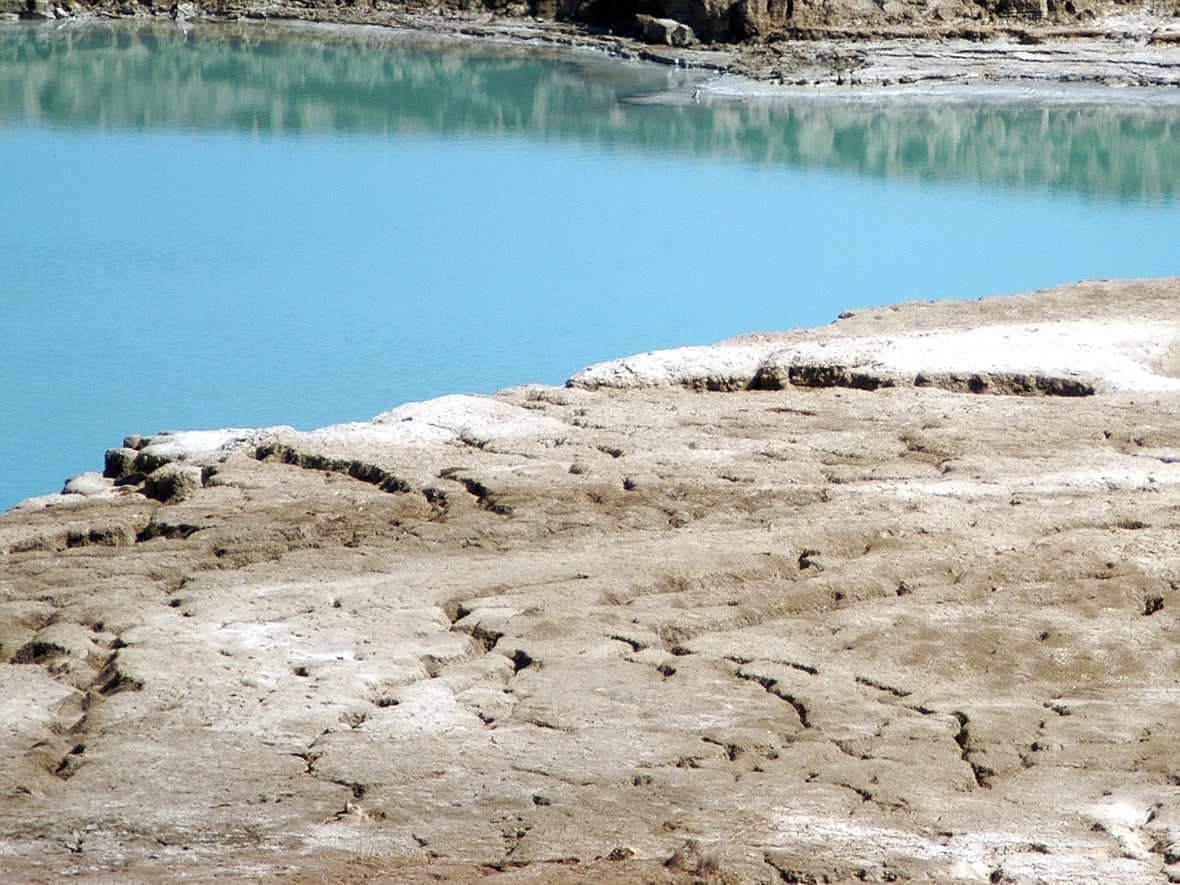The Dead Sea is a popular holiday spot for many. A unique landscape, it features the light turquoise waters of the extremely salty lake, the golden mountains surrounding it, and the majestic desert lying in all directions. However, lately, there have been striking changes in its appearance. The water is receding from the shores, leaving behind dangerous sinkholes in its northern part. The lowest point on Earth, to begin with, its surface level is dropping steadily – more than 1 meter every year. And its total area is getting smaller. In other words, it is shrinking.
Why is the Dead Sea shrinking?
The Dead Sea drying has many people worried. The situation has gotten so bad that some consider the Dead Sea dying. As people living in the area are being adversely affected by the changes happening to the Dead Sea, and as tourism to the area is also being impacted (some beaches have recently closed until further notice due to sinkholes), it is important to explain what is happening.
1. The River Jordan is Dry
Probably the single most significant cause of the Dead Sea recession is the drying up of the River Jordan. In centuries past, the River Jordan was a full, gushing river that flowed into the Dead Sea, replenishing the water naturally lost to evaporation. With the establishment of modern nation-states, approximately 90% of waters from the River Jordan have been siphoned off to support flourishing population growth and agricultural activity in the region. With the River Jordan reduced to a comparative trickle from times past, the Dead Sea is not receiving the necessary flow of freshwater to balance the natural water level.
2. The Climate
The Dead Sea has been shrinking for 100 years since the ruling British first marked the sea level. According to geologists in a report from the BBC, the waterline of the Dead Sea has fallen and risen during different times throughout history. Scientists hold that the fluctuating level of the Dead Sea reflects broader climatic changes. During periods of drought, which are endemic to the hot, desert region in which the Dead Sea lies, there is little to no rainfall to refill the natural depletion of the sea. Unfortunately, it’s the simple fact of the weather that is another culprit in the mystery of the dying Dead Sea.
3. Politics Getting Personal with the Dead Sea
The idea of building a pipeline to channel water from the Red Sea to the Dead Sea – known as the “Red to Dead” plan – was already floated by British engineers during the Mandate period. For many years, political machinations prevented the idea from becoming reality. Plans are finally underway between Israel, Jordan, and the Palestinian Authority to build the pipeline from the Red Sea. However, there are concerns that channeling Red Sea water could have a detrimental effect on the precise mineral and salt makeup of the Dead Sea, its evaporation rate, and the proliferation of algae and other life forms in the water, sediment, and surrounding rock. Filling the Dead Sea with Red Sea water could even have long-term detrimental effects on the unique ecosystem of the surrounding Arava desert. The plan is currently in the final feasibility study stage, with the project slated for completion by 2021.
Although the Dead Sea is used for commercial purposes, including tourism and mineral mining, the drying of the Dead Sea is in fact a political and climatic phenomenon. The commercial industry surrounding the Dead Sea is relatively modern, having only begun in the 1950s. It is dominated by the Dead Sea Works, a company that mines the sea using evaporation ponds, mainly to extract potash for use in fertilizers and other products worldwide.
Based on extensive, current research of governments and NGOs, it appears that the key to restoring the Dead Sea in the proper, natural way is a flourishing Jordan River. Failing that, the Red Sea to Dead Sea pipeline may be a suitably improvised solution. Either way, the drying of the Dead Sea can only be combated by governments based on mutual cooperation and engineering innovation. This is the true, long-awaited answer to the problem of the Dead Sea.
How are sinkholes caused?
Other than a changing landscape, the Dead Sea shrinking has had a major, and devastating, impact on its surroundings. As the water recedes from the shoreline, fresh water from the aquifers surrounding it is also receding. In the process, this fresh water dissolves the salt deposits that are hidden under the surface. With no support, the earth above these deposits collapses – causing sinkholes to appear. In the past two decades, about 3000 sinkholes have appeared all around the Dead Sea. As they appear without warning, they can cause real danger and have so far taken down with the portions of roads, buildings, fields, etc. Hotels surrounding the Dead Sea are also in danger, experts believe, as are the villages and kibbutzim in the area. However, that shouldn’t prevent you from visiting the Dead Sea and enjoying its beauty and attractions: the GSI (Geological Survey of Israel) regularly monitors the area and publishes maps where all dangerous areas are marked every two years. So as long as you’re aware of the situation and paying attention to the signs on the way to Dead Sea, you will be safe.
What can be done about the Dead Sea shrinking?
The one consolation in this situation is that since the Dead Sea levels are falling, its salinity is rising; this means that at some point evaporation will slow down and a new equilibrium will be reached. The Dead Sea will not disappear, even though it will shrink considerably. However, reaching this equilibrium will probably take decades.
Unfortunately, stopping this process is very hard, if not impossible. In 2015 Israel and Jordan signed an agreement stating that they’ll invest $9 million in trying to stabilize the Dead Sea’s water level. This plan includes pumping 300 million cubic meters of water yearly into the Dead Sea and building a canal connecting it with the Red Sea that will supply both countries with water. Hopefully, this plan will at least prevent further deterioration.
What is the Dead Sea prophecy?
Finally, a strange event that has allegedly happened at the Dead Sea recently is leading some people to believe that perhaps we don’t know exactly what’s happening: maybe it’s all because of the Dead Sea drying up prophecy. Last year, a Jewish woman named Samantha Siegel from Jerusalem, discovered that several sinkholes near the Dead Sea have been filled with fresh water and ducks and fish are swimming in them. As the Dead Sea itself is almost completely devoid of animal life, this is highly unusual, and also, as Siegel noticed, reminiscent of a prophecy from the Old Testament. In the Book of Ezekiel, it says that one day, water from Jerusalem will flow east to the Dead Sea, and when they enter it, its own waters will be healed; every live creature that will come to there will live and many fish will be swimming there. Is this what is actually happening now?
This is very intriguing, of course. But to find out for sure, we suggest that you travel to the Dead Sea and see for yourself!



